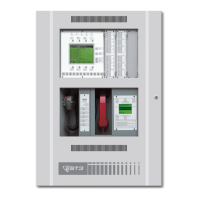System overview
1.34 EST3 Installation and Service Manual
Backup amplifiers
Each cabinet can contain 1 zoned amplifier module to use to
back up the remaining primary zoned amplifier modules installed
in the same cabinet with the following restrictions:
• All the amplifiers must have the same output voltage rating.
• If the cabinet contains older amplifier modules (15- and
30-watt) and newer amplifier modules (20- and 40-watt), the
amplifier used to back up the primary amplifier modules
must be of the older type.
Note: In cases where older and newer zoned amplifiers exist in
the same cabinet, the older modules should be replaced with
newer modules for optimum results.
• The backup amplifier must have an output wattage rating
equal to or greater than the largest primary amplifier it is
backing up. If not, the output capacity of the speaker circuit
is diminished proportionately.
• The wire used to wire the backup amplifier to the other
amplifiers must be the same size or greater than that used to
wire the speaker circuit.
Cabinet space
The 20- and 40-watt amplifiers each require one space on the rail
assembly. The 95-watt amplifier requires two rail spaces.
The number of zoned amplifier modules that can be installed in a
single cabinet is limited by the number of available rail spaces,
the number of power supplies installed in the cabinet, and battery
limits, if any.
Audio channels
The EST3 audio system provides eight (8) simultaneous
channels for distribution of audio signals. The functions of four
of these channels are fixed by the system. These four channels
are referred to by their functions: Page, EVAC, Alert, and
Auxiliary Input channels. The four remaining channels are
referred to as general channels 1 to 4.
Under manual or automatic network control, each amplifier’s
input can be connected to either the Alert channel, the
Evacuation (EVAC) channel, the Page channel, the Auxiliary
Input channel, or one of four (4) general input channels. Should
conflicting commands be issued to a single amplifier, the
amplifier responds to the channel with the highest priority. The
eight channels are prioritized as follows, with the Page channel
having the highest priority

